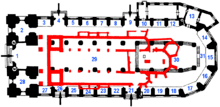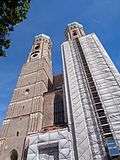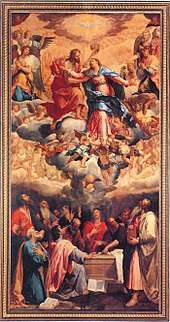Munich Frauenkirche
| Frauenkirche | |
|---|---|
| Dom zu Unserer Lieben Frau | |
| English: Cathedral of Our Lady | |
 | |
 Frauenkirche | |
| 48°8′19″N 11°34′26″E / 48.13861°N 11.57389°ECoordinates: 48°8′19″N 11°34′26″E / 48.13861°N 11.57389°E | |
| Location |
Frauenplatz 1 Munich, Bavaria |
| Country | Germany |
| Denomination | Roman Catholic |
| Website |
www |
| History | |
| Consecrated | 1494 |
| Architecture | |
| Status | Co-cathedral |
| Functional status | Active |
| Architect(s) | Jörg von Halsbach |
| Architectural type | Cathedral |
| Style |
Gothic Renaissance (domes) |
| Years built |
preced. 12th century actual 1468-1488 |
| Completed | 1524 (domes added) |
| Specifications | |
| Length | 109 metres (358 ft) |
| Width | 40 metres (130 ft) |
| Number of domes | 2 |
| Number of towers | 2 |
| Tower height | 99 metres (325 ft) |
| Administration | |
| Archdiocese | Munich and Freising |
| Clergy | |
| Archbishop | Reinhard Cardinal Marx |
| Priest(s) | Hans-Georg Platschek |
| Laity | |
| Director of music |
Lucia Hilz (kapellmeister) |
| Organist(s) | Hans Leitner |
The Frauenkirche (Full name: German: Dom zu Unserer Lieben Frau, English: Cathedral of Our Dear Lady) is a church in the Bavarian city of Munich that serves as the cathedral of the Archdiocese of Munich and Freising and seat of its Archbishop. It is a landmark and is considered a symbol of the Bavarian capital city. Although called "Münchner Dom" (Munich Cathedral) on its website and URL, the church is always referred to as "Frauenkirche" by locals.
The church towers are widely visible because of local height limits. According to the narrow outcome of a local plebiscite, city administration prohibits buildings with a height exceeding 99 m in the city center. Since November 2004, this prohibition has been provisionally extended outward and as a result, no buildings may be built in the city over the aforementioned height. The south tower which is normally open to those wishing to climb the stairs, will, on completion of its current renovation, offer a unique view of Munich and the nearby Alps.[1]
History


Right next to the town's first ring of walls, a Romanesque church was added in the 12th century, replacing a former, late romanesque building and serving as a second city parish following Alter Peter church (its tower nicknamed 'Ole Pete'), which is the oldest. The current late Gothic construction replaced this older church and was commissioned by Duke Sigismund and the people of Munich in the 15th century.
The cathedral was erected in only 20 years' time by Jörg von Halsbach. For financial reasons and due to the lack of a nearby stone pit, brick was chosen as building material. Construction began in 1468.[2] Since the cash resources were exhausted in 1479, Pope Sixtus IV granted an indulgence.

The two towers (north tower 98.57 m, south tower 0.12 m less) were completed in 1488 and the church was consecrated in 1494. However, due to lack of funds, the planned, tall, open-work spires typical of the Gothic style could not be built and the towers had to stay unfinished until 1525. Hartmann Schedel printed a view of Munich including the uncovered towers in his famous Nuremberg Chronicle, also known as Schedel's World Chronicle. However, because rainwater was regularly penetrating the temporary roofing in the tower's ceilings, a decision was made to complete them in a budget-priced design. This is how the building got its famous domes atop each tower and the church became such a non-interchangeable landmark. Their design was modelled on the Dome of the Rock in Jerusalem, which in turn took a lead from late Byzantine architecture and was at that time falsely considered to be Solomon's original temple.[3]
The building has a volume of about 200,000 m³.[4] It is said to having had capacity to house 20,000 standing people. (Church benches for ordinary people were a later introduction.) This is quite remakable for a town that, besides from having had another (first) parish church, did count 13,000 inhabitants only at the end of the 15th century and for a church that was erected to serve but a modest (and second) city parish, merely repacing an earlier, yet significantly smaller construction.
The cathedral suffered severe damage during World War II due to the Allied forces' aerial raids during the latter stages of the war — the roof collapsed, one of the towers suffered severe damage and a lion's share of the immensely precious interior from all centuries since the foundation of the parish was lost either due to bomb raids or in their aftermath, when tons of debris had to be removed somehow.
Major restoration efforts began after the war and were carried out in several stages, the last of which came to an end in 1994.[5]
Architecture


The Frauenkirche was constructed from red brick in the late Gothic style within only 20 years. The building is designed very plainly, without rich Gothic ornaments and its buttresses moved into and hidden in the interior. This, together with the two tower's special design (battered upwards, etc.), lets the construction, mighty anyway, look even more enormous and gives it a near-modern appearance according to the principle of "less is more".
The Late Gothic brick building with chapels surrounding the apse is 109 metres (358 ft) long, 40 metres (130 ft) wide, and 37 metres (121 ft) high. Contrary to a widespread legend that says the two towers with their characteristic domes are exactly one meter different in height, they are almost equal: the north tower is 98.57 metres (323.4 ft) while the south tower is only 98.45 metres (323.0 ft), 12 centimetres (4.7 in) less. The original design called for pointed spires to top the towers, much like Cologne Cathedral, but those were never built because of lack of money. Instead, the two domes were constructed during the Renaissance and do not match the architectural style of the building, however they have become a distinctive landmark of Munich. With an enclosed space of about 200,000 m³, with 150,000 m³ up to the height of the vault, it is the largest hall church in general and the largest brick church north of the Alps.[6]
Interior

Catholic Mass is held regularly in the cathedral, which still serves as a parish church.
It is among the largest hall churches in southern Germany. The interior does not overwhelm despite its size. The hall is divided into 3 sectors (the main nave and two side aisles of equal height (31 metres (102 ft)) by a double-row of 22 pillars (11 at either side, 22 metres (72 ft)) that help enclose the space. These are voluminous, but appear quite slim due to their impressive height and the building's height-to-width ratio. The arches were designed by Heinrich von Straubing.

From the main portal the view seems to be only the rows of columns with no windows and translucent "walls" between the vaults through which the light seems to shine. The spatial effect of the church is connected with a legend about a footprint in a square tile at the entrance to the nave, the so-called "devil's footstep".
A rich collection of 14th to 18th century artwork of notable artists like Peter Candid, Erasmus Grasser, Jan Polack, Hans Leinberger, Hans Krumpper and Ignaz Günther decorates the interior of the cathedral again since the last restoration.[7] The Gothic nave, several of the Gothic stained-glass windows, some of them made for the previous church, and the tomb monument of Louis IV, Holy Roman Emperor are major attractions. For the daily choral prayers Erasmus Grasser created in 1495-1502 the choir stalls with busts of apostles and prophets and small statues which survived the alterations of the Baroque period and the Gothic Revival, but burned in World War II, only the figures had been relocated and preserved. Therefore, the Frauenkirche has still the largest surviving ensemble of characters of late Gothic in Germany. The optical end of the sanctuary forms on a column the St.Mary statue of Roman Anton Boos, which he carried out in 1780 for the abat-voix of the former pulpit. The former high altar painting completed by Peter Candid in 1620 has been moved to the north wall entrance of the sacristy and depicts the Assumption of Mary into heaven .
Teufelstritt, or Devil's Footstep & perpetual wind

Much of the interior was destroyed during WWII. An attraction that survived is the Teufelstritt, or Devil's Footstep, at the entrance. This is a black mark resembling a footprint, which according to legend was where the devil stood when he curiously regarded and ridiculed the 'windowless' church that Halsbach had built. (In baroque times the high altar would obscure the one window at the very end of the church visitors can spot now when standing in the entrance hall.)
In another version of the legend, the devil made a deal with the builder to finance construction of the church on the condition that it contain no windows. The clever builder, however, tricked the devil by positioning columns so that the windows were not visible from the spot where the devil stood in the foyer. When the devil discovered that he had been tricked, he could not enter the already consecrated church. The devil could only stand in the foyer and stomp his foot furiously, which left the dark footprint that remains visible in the church's entrance today.
Legend also says the devil then rushed outside and manifested its evil spirit in the wind that furiously rages around the church.[8]
Another version of that part of the legend has it that the devil came riding on the wind to see the church under construction. Having completely lost his temper, he stormed away, forgetting the wind, which will continue to blow around the church until the day the devil comes back to reclaim it.
Burials
The crypt contains the tombs of the Archbishops of Munich and Freising and among others of these members of the Wittelsbach dynasty:

- Louis IV, Holy Roman Emperor, (reg. 1294-1347)
- Duke Louis V, (reg. 1347-1361)
- Duke Stephen II, (reg. 1347-1375)
- Duke John II, (reg. 1375-1397)
- Duke Ernest, (reg. 1397-1438)
- Duke William III, (reg. 1397-1435)
- Duke Adolf, (reg. 1435-1441)
- Duke Sigismund, (reg. 1460-1467)
- Duke Albert IV, (reg. 1467-1508)
- Duke William IV, (reg. 1508-1550)
- Duke Albert V, (reg. 1550-1579)
- King Ludwig III, (reg. 1912-1918)
Bells
Both towers contain ten bells cast in the 14th, 15th, 17th and 21st century. Their combination is unique and incomparable in Europe. The heaviest bell called Susanna or Salveglocke is one of the biggest bells of Bavaria. It was cast 1490 by Hans Ernst by order of Albrecht IV..[9]
| No. | Audio | Name | Cast in, by, at | Diameter (mm) | Mass (kg) | Note (Semitone-1/16) | Tower |
| 1 | Susanna (Salveglocke) | 1490, Hanns Ernst, Regensburg | 2.060 | ≈8.000 | a0 +3 | North | |
| 2 | Frauenglocke | 1617, Bartholomaeus Wengle, München | 1.665 | ≈3.000 | c1 +6 | North | |
| 3 | Bennoglocke | 1.475 | ≈2.100 | d1 +7 | South | ||
| 4 | Winklerin | 1451, Meister Paulus, München | 1.420 | ≈2.000 | es1 +15 | North | |
| 5 | Praesenzglocke | 1492, Ulrich von Rosen, München | 1.320 | ≈1.600 | e1 +9 | South | |
| 6 | Cantabona | 2003, Rudolf Perner, Passau | 1.080 | 870 | g1 +12 | South | |
| 7 | Frühmessglocke | 1442, Meister Paulus, München | 1.050 | ≈800 | a1 +10 | South | |
| 8 | Speciosa | 2003, Rudolf Perner, Passau | 890 | 540 | h1 +10 | South | |
| 9 | Michaelsglocke | 840 | 440 | c2 +12 | South | ||
| 10 | Klingl (Chorherrenglocke) | 14th century, anonymous | 740 | ≈350 | es2 +13 | South |
See also
| Wikimedia Commons has media related to Frauenkirche, Munich. |
References
- ↑ "Rising from Rubble 1945-1960". Munich Official City Portal. 2010. Retrieved 21 December 2010.
- ↑ "Cathedral to our lady". Munich-info. 2007. Retrieved 21 December 2010.
- ↑ "Building History (in German)". Der Münchner Dom. 2006. Retrieved 21 December 2010.
- ↑ Calculation of the volume of the Frauenkirche (in German)
- ↑ "Munich churches:Frauenkirche". My Travel Munich. 2007. Retrieved 21 December 2010.
- ↑ Calculation of the volume (in German)
- ↑ Das Hochaltarbild in die Munich Frauenkirche (in German)
- ↑ "Frauenkirche". Destination Munich. 2010. Retrieved 21 December 2010.
- ↑ Sigrid Thurm (1959), "Ernst, Hans", Neue Deutsche Biographie (NDB) (in German), 4, Berlin: Duncker & Humblot, p. 628; (full text online)
External links
- Official Website
- Munich Frauenkirche - video
- Munich Frauenkirche Photo Spread
- Warburg Institute Iconographic Database (images of the church interior)